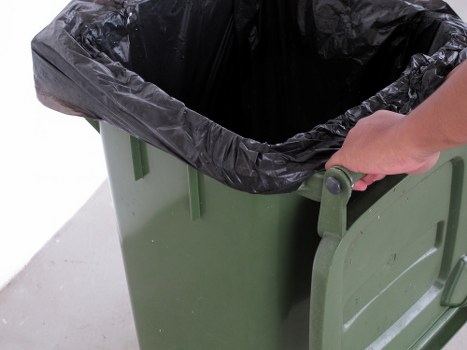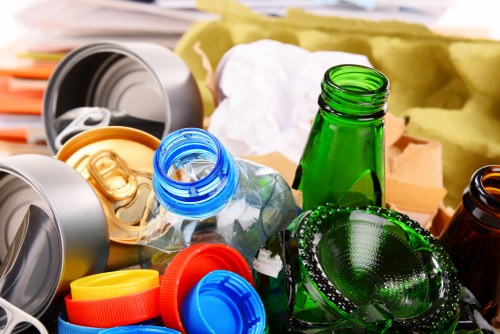Construction Waste Clearance in Camden Town

Construction projects in Camden Town are thriving, thanks to the area's vibrant culture and ongoing development. However, with growth comes the inevitable challenge of managing construction waste. Efficient construction waste clearance is essential to maintain the area's aesthetic appeal and environmental sustainability.
Proper waste management not only ensures a clean and safe environment but also complies with local regulations. Neglecting to handle construction debris appropriately can lead to fines and project delays, impacting both contractors and property owners.
In this comprehensive guide, we'll explore the best practices for construction waste clearance in Camden Town, helping you navigate the complexities of debris removal with ease.
Why Construction Waste Clearance Matters

Effective waste clearance plays a crucial role in the success of any construction project. Here are some key reasons why it's important:
- Environmental Protection: Proper disposal minimizes environmental impact and promotes sustainability.
- Regulatory Compliance: Adhering to local laws avoids legal complications and fines.
- Project Efficiency: Organized waste management streamlines workflow and prevents site clutter.
By prioritizing construction waste clearance, Camden Town can continue to develop without compromising its unique character or environmental integrity.
Types of Construction Waste

Understanding the different types of construction waste is vital for effective clearance. Common categories include:
- Concrete and Masonry: Debris from bricklaying, concrete pouring, and other masonry work.
- Wood: Offcuts, pallets, and other wood materials from framing and carpentry.
- Metals: Scrap metal from plumbing, wiring, and structural components.
- Plastics and Composites: Waste from insulation, piping, and paneling.
- Hazardous Materials: Asbestos, lead-based paints, and other toxic substances require special handling.
Proper identification and segregation of these materials facilitate recycling and safe disposal, reducing the overall environmental footprint.
Steps for Effective Waste Clearance

Implementing a systematic approach to waste clearance ensures that debris is managed efficiently and responsibly. Follow these essential steps:
- Assessment: Evaluate the project site to identify the types and volumes of waste generated.
- Segregation: Separate recyclable materials from non-recyclable waste to optimize disposal methods.
- Collection: Use appropriate containers and vehicles to transport waste safely.
- Recycling and Disposal: Ensure that recyclable materials are sent to proper facilities and hazardous waste is handled according to regulations.
- Documentation: Keep detailed records of waste management practices for compliance and auditing purposes.
Adhering to these steps not only promotes efficiency but also fosters a culture of sustainability within the construction industry.
Choosing the Right Waste Clearance Service

Selecting a reliable waste clearance service is pivotal for successful debris management. Consider the following factors:
- Experience: Opt for companies with a proven track record in construction waste clearance.
- Licensing and Certification: Ensure the service provider complies with local regulations and possesses necessary certifications.
- Recycling Practices: Choose services that prioritize recycling and environmentally friendly disposal methods.
- Flexibility: A service that can adapt to your project's specific needs and timelines is invaluable.
- Cost-Effectiveness: Compare pricing structures to find a service that offers quality without breaking the bank.
By carefully evaluating these aspects, you can partner with a waste clearance service that aligns with your project's goals and values.
Environmental Impact of Construction Waste

The environmental repercussions of construction waste are significant. Improper disposal can lead to:
- Soil and Water Contamination: Hazardous materials can leach into the ground, affecting local ecosystems.
- Air Pollution: Burning construction debris releases harmful pollutants into the atmosphere.
- Resource Depletion: Discarded materials represent wasted resources that could otherwise be recycled.
Mitigating these impacts through effective waste clearance is essential for preserving Camden Town's natural beauty and public health.
Recycling and Reuse Opportunities

Recycling construction waste not only reduces environmental harm but also offers economic benefits. Commonly recycled materials include:
- Concrete: Crushed and reused as aggregate in new construction projects.
- Wood: Reclaimed for use in furniture, flooring, and other applications.
- Metals: Reprocessed for incorporation into new building materials.
- Plastics: Recycled into various products, reducing the need for virgin materials.
Embracing recycling and reuse initiatives fosters a sustainable construction industry and supports Camden Town's commitment to environmental stewardship.
Regulations and Compliance

Compliance with local regulations is non-negotiable in construction waste clearance. Key considerations include:
- Waste Disposal Permits: Obtain necessary permits for the transportation and disposal of construction debris.
- Hazardous Waste Handling: Adhere to strict guidelines for managing and disposing of toxic materials.
- Reporting Requirements: Maintain accurate records of waste management activities for regulatory review.
- Enforcement and Penalties: Be aware of the consequences of non-compliance, including fines and project shutdowns.
Staying informed and compliant with these regulations safeguards your project from legal setbacks and promotes responsible waste management practices.
Innovative Waste Management Solutions

Advancements in waste management technology offer innovative solutions for construction debris clearance. Some noteworthy approaches include:
- Automated Sorting Systems: Utilize machinery to efficiently separate different types of waste.
- On-Site Recycling: Implement facilities that process waste materials directly at the construction site.
- Green Building Practices: Incorporate sustainable design principles that minimize waste generation.
- Digital Tracking: Use software to monitor waste production and disposal in real-time.
These innovative solutions enhance the efficiency and effectiveness of construction waste clearance, aligning with modern sustainability goals.
Benefits of Professional Waste Clearance Services

Engaging professional waste clearance services offers numerous advantages for construction projects in Camden Town:
- Expertise: Professionals possess the knowledge and skills to handle diverse waste materials safely.
- Time-Saving: Outsourcing waste management allows you to focus on core project activities.
- Cost Efficiency: Professionals can optimize waste disposal methods, reducing overall costs.
- Compliance Assurance: Experts ensure adherence to all relevant regulations and standards.
- Enhanced Safety: Proper waste handling minimizes the risk of accidents and injuries on-site.
By leveraging the expertise of waste clearance professionals, your construction project can achieve greater efficiency, safety, and sustainability.
Scheduling and Planning Waste Clearance

Effective scheduling is critical for seamless waste clearance. Consider the following tips:
- Early Planning: Integrate waste management into the initial project plan to anticipate needs and allocate resources accordingly.
- Regular Pick-Ups: Schedule frequent waste collection to prevent accumulation and site congestion.
- Flexibility: Allow for adjustments in the schedule to accommodate changes in project timelines or unexpected waste generation.
- Coordination: Communicate with waste clearance providers to ensure timely and efficient service delivery.
Strategic planning ensures that waste clearance supports, rather than disrupts, the overall project workflow.
Cost Considerations

Understanding the costs associated with construction waste clearance allows for better budgeting and financial planning. Key cost factors include:
- Volume of Waste: Larger projects generate more debris, increasing disposal costs.
- Type of Waste: Hazardous materials require specialized handling, which can be more expensive.
- Frequency of Collection: More frequent pickups may result in higher overall costs.
- Recycling Fees: Recycling materials may involve additional processing charges.
- Transportation: Distance to disposal or recycling facilities affects transportation costs.
By meticulously evaluating these factors, you can optimize your waste clearance strategy to balance cost and effectiveness.
Maximizing Recycling Efforts

Maximizing recycling efforts contributes to sustainability and cost savings. Here are strategies to enhance recycling:
- Material Identification: Clearly label recyclable items to facilitate easy sorting and processing.
- Dedicated Recycling Bins: Provide specific containers for different types of recyclable materials on-site.
- Employee Training: Educate workers on proper recycling practices to ensure compliance and efficiency.
- Partnerships: Collaborate with local recycling facilities to establish a streamlined process.
These practices not only support environmental goals but also reduce the volume of waste requiring disposal, leading to lower costs.
Case Studies: Successful Waste Clearance in Camden Town

Examining successful waste clearance projects in Camden Town provides valuable insights and best practices. Here are a few examples:
- Residential Development: A large-scale housing project implemented on-site recycling bins and partnered with local recycling centers, resulting in a 40% reduction in landfill waste.
- Commercial Construction: A commercial building project utilized automated sorting systems to efficiently manage diverse waste streams, enhancing overall project efficiency.
- Renovation Project: A historic building renovation incorporated careful waste segregation and reuse of materials, preserving the building's character while minimizing environmental impact.
These case studies demonstrate the effectiveness of proactive waste management strategies in various construction contexts.
Lessons Learned

Drawing lessons from past projects can inform future waste clearance efforts. Key takeaways include:
- Early Integration: Incorporate waste management plans from the project's inception to anticipate challenges and allocate resources effectively.
- Continuous Monitoring: Regularly assess waste generation and disposal practices to identify areas for improvement.
- Flexibility: Adapt waste management strategies to accommodate project changes and unexpected waste streams.
- Stakeholder Engagement: Involve all parties, including contractors and workers, in waste management initiatives to ensure collective responsibility.
Implementing these lessons fosters a culture of continuous improvement and sustainability in construction waste clearance.
Future Trends in Construction Waste Management

The construction industry is evolving, with waste management practices adapting to new technologies and sustainability goals. Future trends include:
- Circular Economy: Emphasizing the reuse and recycling of materials to create a closed-loop system.
- Digital Solutions: Leveraging software and IoT devices to track and manage waste in real-time.
- Sustainable Materials: Increasing use of eco-friendly and recyclable building materials to reduce waste generation.
- Advanced Recycling Technologies: Developing more efficient methods for processing and repurposing construction debris.
Staying abreast of these trends ensures that construction waste clearance practices remain effective and aligned with global sustainability objectives.
Embracing Sustainability

Integrating sustainability into waste management strategies enhances environmental responsibility and project appeal. Ways to embrace sustainability include:
- Green Certifications: Pursue certifications like LEED to validate sustainable practices.
- Energy-Efficient Processes: Utilize energy-saving equipment and methods in waste clearance operations.
- Community Engagement: Involve the local community in sustainability initiatives to build support and awareness.
- Innovative Design: Incorporate design elements that minimize waste production from the outset.
These sustainable approaches not only benefit the environment but also enhance the reputation and success of construction projects in Camden Town.
Conclusion

Construction waste clearance is a critical component of successful and sustainable development in Camden Town. By understanding the importance of waste management, implementing effective strategies, and embracing innovative solutions, stakeholders can ensure that construction projects contribute positively to the community and environment.
Partnering with professional waste clearance services, adhering to regulations, and prioritizing recycling and sustainability are key to achieving these goals. As Camden Town continues to grow, responsible waste management will play a pivotal role in maintaining its charm and ecological balance.
Contact us today to learn more about our expert construction waste clearance services and how we can support your next project.